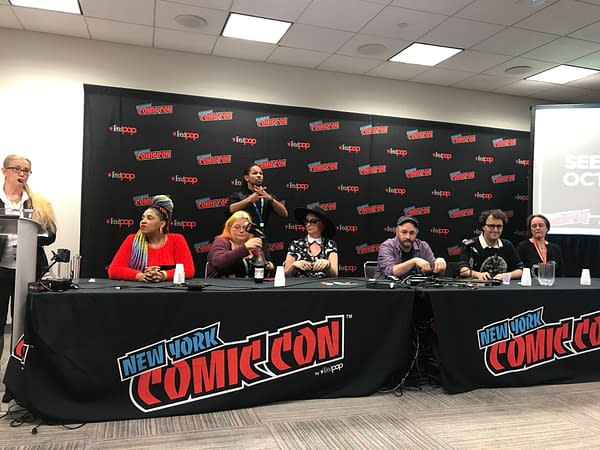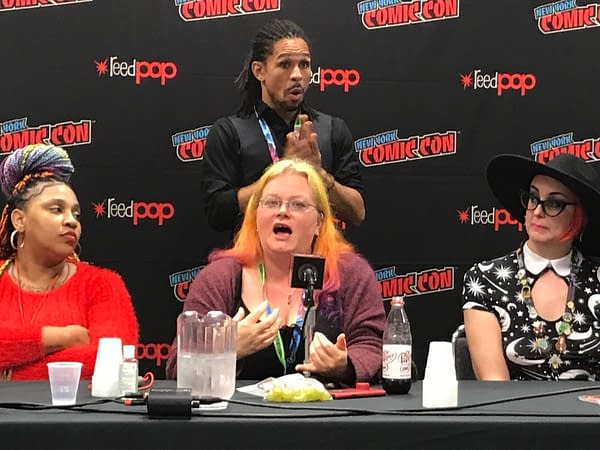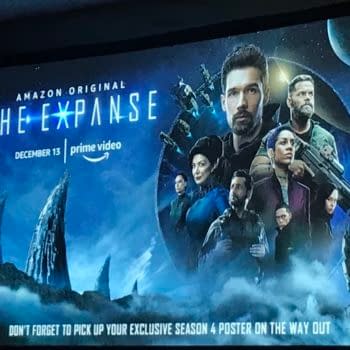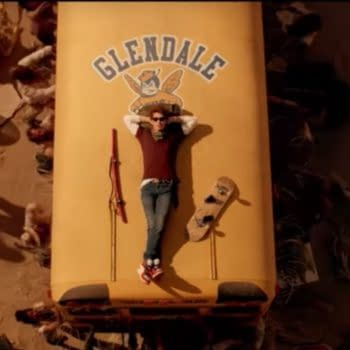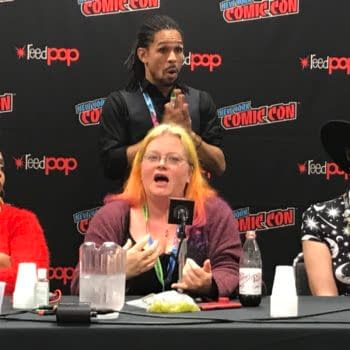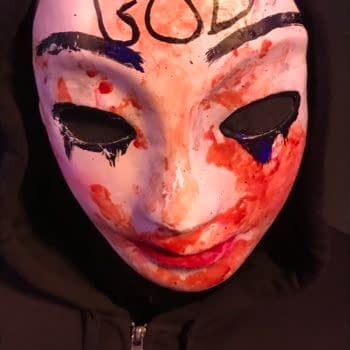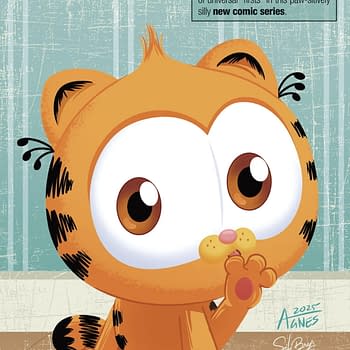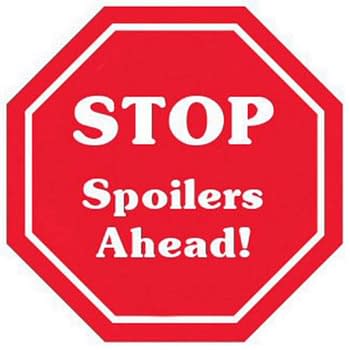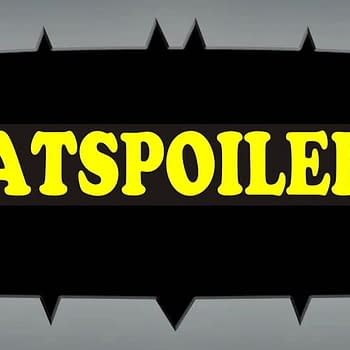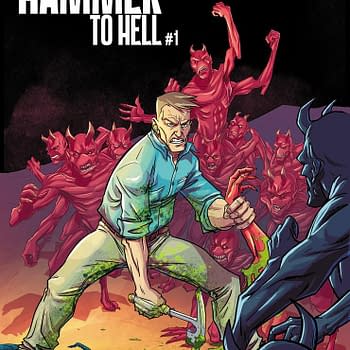Posted in: Comics, NYCC | Tagged: comics. nycc, disability, disabled
Creating While Chronic – The Challenges and Strategies of Being a Disabled Artist, the #NYCC Panel
Written by Amanda Gurall
An able-bodied and healthy creator knows how gruelling the process can be even on a good day but when pushing your creative limits is accompanied by physical and mental limitations it can render one's work impossible or even harmful to complete. How do you navigate a creative career and find that fine line between balance and destruction? It is a lifelong process for most chronically ill people that starts with education and discussion so we were happy to welcome some accomplished panelists today to get the conversation started.
Tee Franklin(Bingo Love), Seanan McGuire (October Daye), Chandra Free (The God Machine), David Gallaher (The Only Living Boy), Jeremy Fuscaldo (Amelia Enmity), and Cat Staggs (Crosswind) were moderated by Colleen Doran (Sandman) and ASL was provided by Brandon Kazen-Maddox.
One of the first topics discussed was about the convention itself and how to best navigate these massive events. Mobility and sensory issues are some of the hardest to manage in a con environment and having to remain professional in the face of pain and difficulty is especially challenging. Fortunately, convention centers offer accessible ramps and restrooms but this does not come close to meeting the needs of many attendees. Elevator waits can make you miss an event and waiting an hour for the restroom is unacceptable and can lead to a humiliating situation. Seanan MacGuire noted that although it is illegal for an able-bodied person to occupy the disabled stall when a disabled person is requiring one, it is never enforced.
Tee Franklin shared that in Artist's Alley even if she gets the table end spot that she requires, she has had trouble having enough room with her mobility scooter and with people doing things like calling her scooter "clutter" which is in the way of able-bodied artists. David Gallaher pointed out that show floors do not give fair warning for sensory triggers that can start a seizure such as loud bass music and flashing lights. I noticed that although the ADA entrance is a big help, once inside the NYCC will call and medical badge area the signs for each line and help desk were posted too low to be seen by anyone in a scooter or wheelchair once the area was filled with fans. The day is an endless navigation and struggle. Some important things you can do to help your disabled or chronically ill fellow fans at a con according to the panelists:
*Do not stop in the middle of a walkway
*If you do stop abruptly and someone using a mobility device bumps into you, recognize that you were the person at fault as most cannot stop as fast as an able-bodied person
*Remember that people using ADA line accommodations are not receiving early entry without good reason and statistically only approximately 2% of people pretend to be disabled to gain extra access.
*Disabled people do not exist for you to be inspired by.
*Asking what is "wrong" with a total stranger is offensive. We do not owe you explanations or excuses for our appearance or behaviors.
*Be aware that quiet rooms are not a place to hang out and chat, please do not use unless you have an actual need to do so.
*Do not use elevators and ramps unless you have a physical need.
*Many disabilities are invisible to you, they do exist.
*Kicking, climbing on, jumping over, leaning on or sitting in or on a person's mobility device makes you a really terrible person and you should probably just exit the con.
*This is not a complete list, however, it is a good start. Listen to people when they tell you about their experiences and needs and try to do what is right for each other.
Chandra Free discussed her issues with crowds and panic attacks, noting that she has broken down into tears because of con crowds. Remember this isn't just a fun day for her it is networking and promotion as well and can potentially be embarrassing in front of fans or an employer. Most of the artists have found ways to meet their deadlines and work with their editors and it seems most of the major publishers are understanding and work with them although there are definitely exceptions. Jeremy Fuscaldo spoke about being taken advantage of by a client who either did not pay him for weeks of work or who undervalued his work once they did pay. It is unacceptable that some people see anyone who is neurodiverse, disabled or chronically ill as someone who should work for free. Every artist has been in that position but it is much more frequent for anyone who some consider to be "other".
There have been times where all of the artists said they pushed themselves too hard for their work and have ended up with horrible physical repercussions. It's all about that balance and setting yourself up with practical solutions and hard boundaries with work and socializing. The creators discussed several different strategies and helpful tools that I hope can be helpful to anyone reading this and recognizing themselves.
Seanan limits her social media exposure and because her OCD can lead to destructively long writing sessions she lines up gaming die on the keyboard and removes one every 100 words, so when the keyboard is clear she stops to rest.
Chandra Free has BiPolar disorder and made a pact with herself years ago not to give up and to make the best of her one life to live. She has a daily schedule to keep herself productive and in a good place.
David writes between 4am to noon every day because thee are the least distractions and triggers at that time. He uses the Pomodora Technique, a bullet journal, the Freedom app, a whiteboard in studio and a Gant chart to stay organized visually.
Jeremy Fuscaldo uses eyeglasses with screen use filters to reduce eye issues and fatigue and he has gone to speech therapy for help with his communication skills and touching up his professional correspondence. As someone on the autism spectrum he finds group therapy to be very beneficial as well.
Cat Staggs has been diagnosed with Hashimoto's and she follows a restrictive diet tailored to her along with medication. She also uses filtered lenses and white noise while she works and finds the support from her wife helps to keep her balance in check. She went through five doctors to be diagnosed and wanted to note that one in six women have this illness and awareness has to be raised.
This panel was a personal one for me as a disabled person and it was quite emotional to have an honest discussion and to have so much understanding in a panel room. Each of the panelists, as well as the moderator, had so much to add and shared so much of themselves. I truly hope that it will lead to just a little more compassion and understanding as well as change in our community. David Gallaher ended the afternoon by speaking about the shame he felt recently when he had a seizure on a plane mid-flight. At first, he felt terrible that his issue had caused such a major disruption for the other passengers, "But at the same time I was like you know what? Things happen…I don't owe anybody an apology." Disabled and chronically ill people are human beings who coexist in a very different world than others and should be offered opportunities for equal access and respect. Let's keep this discussion going by sharing strategies and recommendations for creating while chronic or disabled in the comments and in person and try to be more aware of other people and how you can help at your next convention.


